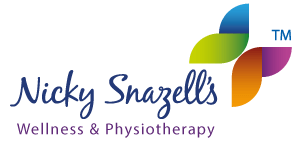What’s The Difference And Why It Matters To You
Shockwave therapy has been around for years and now many clinics use it. Most of what’s out there, though, is radial shockwave. It’s great technology and has helped thousands of people recover from injury and get out of pain. We know, because we’ve used it for years ourselves and we’re big believers in it.
But like most things in life, one size doesn’t fit all. And that’s where focused shockwave comes in.
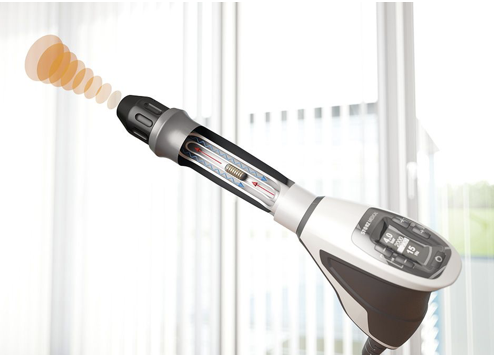
How Shockwave Works
Both types use acoustic energy (sound waves) to stimulate healing. These waves kick start your body’s own repair process, improving blood flow, helping new tissue grow, breaking down stubborn scar tissue, and reducing pain.
The key difference is how far and how accurately the energy travels.
A radial shockwave is like a ripple spreading across a pond. It starts strong at the surface and gradually fades as it goes deeper. That makes it perfect for treating more superficial problems, such as:
- Plantar fasciitis (also known as Policeman’s Foot)
- Tennis or golfer’s elbow
- Achilles tendinopathy (the upper part, near the skin)
- Shoulder or knee pain near the surface
- Calcific tendonitis

It’s safe, effective and widely available. We have several radial machines at our clinic because they deliver great results when used for the right problems.
Focused Shockwave. The Specialist Tool
Focused shockwave is a very different animal, and it’s rarely available in the UK. Instead of spreading out, it converges at a specific point deep in the tissue. Think of it like using a magnifying glass to focus sunlight. The energy can reach far deeper and be positioned much more precisely, even pinpointing structures several centimetres below the skin.
This opens the door to treating things that radial shockwave simply can’t reach:
- Deep-seated tendon and muscle injuries
- Bone stress or delayed healing
- Chronic hip, back or pelvic pain
- Conditions that have resisted other forms of treatment
It’s horses for courses
At the Nicky Snazell Clinic, we use both technologies because we know they each have their place. If the injury is close to the surface, radial shockwave is ideal as it’s efficient, comfortable and proven.
But if the problem lies deeper, a focused Radial Shockwave is the tool for the job. It can go right to the source of the pain with pinpoint accuracy, triggering the healing process exactly where it’s needed.
Why this matters to you
Very few clinics have focused shockwave, and they rely on radial shockwave, which limits what they can treat.
By having both radial and focused shockwave, we can match the treatment to the condition, not the other way round. That means faster recovery, longer-lasting results, and fewer frustrations when a stubborn injury just won’t shift.

Focused shockwave represents a big leap forward in non-invasive healing. And, as you’ll see in our next blog, it’s not just a new gadget, it’s part of a much bigger step in precision pain treatment.
If you are in pain and nothing has helped, then our combination of both radial and focused shockwave might just be the technology that makes the difference.
If you are in pain, we can help
Call Now 01889 881488
20% Discount
Make sure you book and pay for your orthotics on either the 27th or the 28th of November
Here is your chance to make a big saving before Christmas.

20% Discount
We can provide state-of-the-art Phits 3D printed orthotics, which are designed specifically for you to correct any problems with how you walk or run. Such problems can cause pain not only in your feet and ankles, but also in your knees, hips and spine as far up as your neck.
Not surprisingly, everybody is different, and that’s why it’s important to get orthotics that are made specifically for you to correct all the issues causing these problems. That in turn requires a comprehensive assessment with therapists who have specialist skills and access to specialist technology and software. Our assessments include both static testing on pressure plates and dynamic testing on a treadmill, both of which include bespoke software.
It may well be we have already supplied you with orthotics which have worked well for you in he past, but which are now well worn to the extent that they are no longer providing you the help you need. If you feel that you would benefit from a new pair of orthotics, or feel that a second pair would provide improved convenience, then now is a great time to invest and make a 20% saving.
Three Reasons To Take Advantage Of This Offer
- Enhanced Comfort
Experience the unmatched support and relief that our Phits 3D printed orthotics provide. A second pair ensures you can enjoy this comfort in multiple shoe types.
- Versatility
Have different shoe styles for different occasions? Don’t compromise on support! Get a second pair and enjoy the benefits if Phits orthotics no matter what you’re wearing.
- Time Saving
Avoid the hassle of transferring your orthotics between different shoes. A second pair ensures you’re always prepared to step out comfortably.
Keen To Claim Your 20% Discount Now?
- If you would like to order an exact replica, simple!
- Looking for a new style for different footwear? Please let us know your requirements and our experienced team will assess your needs and advise accordingly.
We have specific Phits orthotic designs that can be catered for:
- Daily use footwear (narrow, standard or wide fit)
- Dress shoes
- Walking boots
- Safety boots
- Running shoes
- Golf spikes
- Football boots
- Cycling cleats
- Ski boots
- Rugby boots
- Cricket shoes
- Racket sport shoes
- and more…
Please note that if you bought orthotics from us that are not the Phits 3D-printed type, we will need to reassess you for Phits.
If you have no need for orthotics, then we apologise for troubling you. Please click on the button below, and we will make sure we don’t bother you again with any future orthotic offers.
Call the clinic the 27th or 28th November to get your 20% saving 01889 881488

20% Discount
This offer also includes our latest Focused Shockwave and NASA-developed EMTT technology, both of which are rarely available in the UK.
Here is your chance to make a big saving before Christmas.
20% Discount
We will give you a 20% discount on all your future appointments, up to and including 31st March 2026, and paid for in full on either Thursday 27th or Friday 28th November.
That means if you plan well ahead, you will be able to keep making savings well into 2026. This is particularly beneficial to the large number of clients on one of our preventive treatment plans, as they will naturally book their next appointments well in advance.
Some of you will suffer from a chronic condition, like arthritis, which means the cause of your pain is not treatable, but your pain can be kept well under control, allowing you to live your life as you wish. If you suffer from chronic pain and are not already on one of our preventive wellness or maintenance plans, now is the perfect time to get on board and make the most of your 20% discount.
Don’t miss out and regret it afterwards. Book your appointments on 27th or 28th November
Monday 20th October
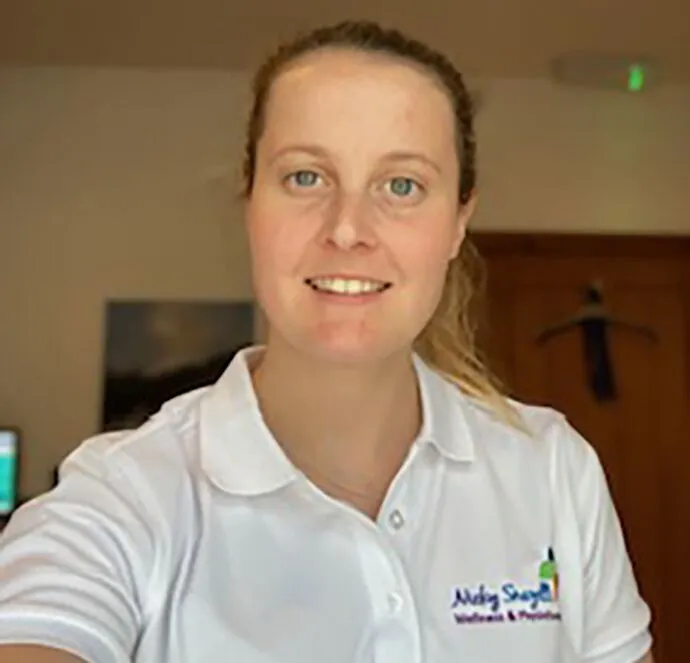
After taking 10 months off to work in Australia and then travel around the Far East, we are delighted to announce that Lowri is back in the UK and will be rejoining our clinic on Monday, 20th October.
For those of you who missed being treated by Lowri in the past and would like to be one of the first to welcome her back, now is the time to call us and book your appointment.
One thing is for sure: Lowri will never run out of exciting stories to tell you about her travels.
Book now to avoid disappointment!
A gentle guide to the Mummy MOT.
If you are a mum - whether your baby is six weeks, six months, or six years old, I want you to know this:
- Your body matters
- Your recovery matters
- You matter
You have grown and birthed a whole human - that's incredible! And just like any physical event (like running a marathon or having surgery), your body deserves expert support to recover, rebuild and thrive.
That's where the Mummy MOT comes in.
Wondering if a Mummy MOT is for you? (Spoiler alert- it probably is!)
Let's dive into the who, what, why and how of it all - because this could be your first step to truly feeling like yourself again.
Who?
If you've had a baby vaginally or via C-section, this is for you. Whether it was your first or your fifth, whether it was six weeks or six years ago, a Mummy MOT can help.
This isn't just for new mums in the early days. If you've notice things like:
- leaking when you sneeze, laugh, run
- a feeling of heaviness down there
- ongoing back, hip or pelvic pain
- a tummy gap / bulge that hasn't gone away
- pain in sex / difficulty getting back to intimacy.
- or even if you feel fine but you want reassurance you're recovering well then a Mummy MOT is 100% for you!
Why?
Why do I need a Mummy MOT? Let's be honest, after birth, the focus tends to shift completely to your baby. You are told your six week checkup is the green light to ‘get back to normal’ but very little attention is paid to how your body is actually doing.
Most postnatal checks barely scratch the surface.
The truth? Many women live with issues they think are just ‘part of being a mum’. But although leaking, pain and discomfort are common, they are not normal, and they can be resolved with the right support!
The Mummy MOT is about giving you that space. To be heard. To be assessed. To be looked after.
What?
What actually is a Mummy MOT? A Mummy MOT is a specialist postnatal checkup with a trained woman's health physio (like Lauren!) that looks at:
- your pelvic floor function
- abdominal wall checking for DRA / separation
- posture and core
- how your body is moving, holding an compensating
- Any aches, pains or concerns, both physical and emotional
We chat, we assess we make a plan that's tailored to you.
It's not about judgement. It's about empowerment. This is your safe space to ask all the questions you weren't sure you could ask. And to then get real answers.
When should I have a Mummy MOT?
Any time after six weeks postpartum is ideal. The main thing to know is it's never too late!
If you're struggling with sex or just want to reconnect with your body it doesn't matter if you're six weeks or sixteen years postpartum, you deserve some total loving care!
How does it work?
Here is what to expect:
1. An initial Mummy MOT assessment
Includes a 60 minute session to assess pelvic floor, abdominal wall and muscles, posture, breathing, movement patterns and any other concerns you may have. We'll talk about your birth experience, your symptoms (if any), your sex life and your goals - whether that's getting back to activity, lifting your child with ease or feeling comfortable in your own skin again.
2. Tailored plan
Based on your assessment, we will give you a personalised rehab plan. This could include pelvic floor exercises [don't worry, it's not just squeeze, hold and hope!], movement work, postural support and core rehab.
3. Follow up support
Many women find follow up appointments helpful to guide their recovery and I'll be beside you every step of your healing journey.
Final thoughts [and a little encouragement)
Mums, I know how easy it is to put yourself last. But your health isn't a luxury, it's a foundation. You deserve to feel strong, confident and supported in your postnatal journey. So whether you're still bleeding or back at work, exhausted or energised, uncertain or curious, I invite you to take that first step.
Let's get you booked in for your Mummy MOT! This is your time!
If you are suffering from any postpartum problems or concerns, we can help.
Call 01889 881488 now and ask for a Mummy MOT assessment with Lauren
How pelvic health physio can help you heal.
Let's be honest, pelvic pain can be confusing, frustrating and even isolating. Maybe you've been told ‘it's just period pain’ or that ‘it’s normal after or when carrying a baby’ or worse …… that ‘it’s all in your head’.
But deep down, you know something doesn't feel right and you're looking for real answers.
Click here to read on
As a women’s health physio, I want you to hear this loud and clear: pelvic pain is real, it's valid, and it is something we can treat.

Whether your pain is sharp, dull, constant, or only shows up during certain activities - like sex, exercise or sitting too long, this blog will help you understand how physio can support your healing.
So let's talk anatomy in a non- overwhelming way. Pelvic pain can be felt in your lower abdomen, pelvis, lower back, hips and pelvic floor area. Think of your pelvis as the foundation of your body. It's literally the base that supports your spine, hips, core and internal organs - and inside your pelvis lives your pelvic floor
If any part of this system is out of balance, your body can start to sound the alarm of pain -it’s a signal, not a failure.
Where is it coming from?
Pelvic pain can come from many different sources and often more than one at a time:
- Hormonal / organ related pelvic pain.
e.g. Endometriosis, PCOS, painful periods
- pain often linked to your cycle
- cramping deep ache sharp pain
- might also be bladder and bowel symptoms
- can cause pain in sex and tampon use
- nervous system driven pain. E.g. vaginismus / vulvodynia, chronic pelvic pain syndrome
- pain that lingers, flares in stress and feels hypersensitive
- might feel like burning / rawness
- may happen without clear injury or diagnosis
- often involves a very on edge nervous system
- MSK pelvic pain (this is a big one!) e.g. pelvic floor muscle tension / weakness, hip, back, SIS issues. Coccyx pain, posture / movement related pain, pelvic girdle pain.
This type of pain is super common, especially if you sit for long hours, have had a baby or are having a baby, or if you are active or sporty. Typical symptoms are:
- deep aching in buttocks and hips
- pain in sitting, standing or walking
- feeling like your pelvic floor is tight, hard to relax
- pain after exercise and certain movements
- postpartum and post surgical pelvic pain
- pain after birth even years later
- discomfort from scar tissue (C-section, episiotomy)
- muscle tightness / weakness from carrying or feeding position or lifting
- heaviness / dragging sensations - especially later in the day
- Bladder or bowel related pelvic pain
e.g. incomplete emptying, constipation, urinary incontinence
- pain in peeing or bowel movements
- constant need to go / trouble emptying
- pressure / burning tension in lower tummy / pelvic floor
In short…. Pelvic pain can be complex, but you're not alone.
In short…. Pelvic pain can be complex, but you're not alone.
The body is incredibly interconnected and often pelvic pain is a mix of muscles, nerves, joints, hormones, stress and lifestyle, and acts all tangled together.
How can pelvic health physio help?
We take a whole body approach - not just treating the pain, but helping you understand why it's happening and what you can do to feel better. That might include:
happening and what you can do to feel better. That might include:
- gentle internal / external pelvic floor release
- exercises to support hips, core pelvic floor and posture
- breathing plus relaxation strategies to calm the nervous system
- education around habits, triggers and simple lifestyle shifts
- support returning to sex exercise or daily life, without fear
You deserve relief now. You don't have to wait until it's bad enough and you definitely don't have to do it alone.
Booking an appointment is a powerful first step towards clarity confidence and comfort in your own body.
Pelvic pain? Call now. We can help.
Call 01889 881488 and ask for a Women’s Health appointment with Lauren.
Because it’s a lot more common than you may think. More importantly though is that it’s very treatable. Maybe it’s bladder leaks when you laugh, cough, sneeze or even run.
You are not alone and you don’t have to suffer in silence.

Let’s talk about something a lot of women quietly live with bladder leaks and urgency. Whether it’s a little dribble when you sneeze, or a sudden urge that you just can’t make it to the toilet in time, it can feel frustrating, embarrassing and isolating. But here is the good news. You are not alone and it is absolutely treatable.
What Is Urinary Incontinence?
Urinary Incontinence simply means involuntary leaking urine. There are a few common types:
- Stress induced urinary incontinence which is typically when you laugh, sneeze, cough, jump, run or lift.
- Urge Urinary Incontinence is when a sudden and strong need to go occurs and you don’t always make it in time.
- Mixed Urinary Incontinence is a combination of both stress & urge.
These can happen during pregnancy, after birth, during menopause or seemingly, out of nowhere. But no matter when it starts, you don’t have to put up with it.
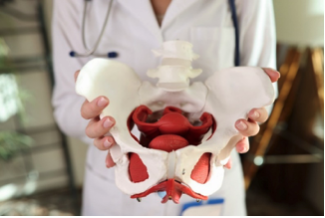
How Can Women’s Health Physiotherapy Help?
-
As a qualified Women’s Health Physiotherapist, I am trained to assess and treat the muscles and systems that support your bladder and pelvic floor. I will work with you to:
- Understand why leaking is happening
- Rebuild your pelvic floor strength, co-ordination and control
- Manage urgency and retrain bladder habits
- Give you simple, effective strategies that fit your life
It’s always personal, private and tailored to your needs, without judgement.
If you don’t want to suffer any longer, we can help. Call the clinic and ask for an appointment with Lauren
That’s what we hear from so many women, sometimes in tears, sometimes with a nervous laugh when they finally open up about their pelvic health. Maybe it’s bladder leaks when you laugh or sneeze. Maybe it’s pain during sex. Maybe it’s discomfort that started after having a baby, or one of those “unspoken” changes around menopause. Whatever it is
- Because you think it’s something you have to live with, or
- Because it’s embarrassing, or
- Because no one ever talks about it
UNTIL NOW
You are not alone and you don’t have to suffer in silence.
Introducing Women’s Health Physiotherapy At The Nicky Snazell Clinic
We are proud to now offer a dedicated Women’s health physiotherapy service, led by our compassionate and highly skilled physiotherapist, Lauren.

This isn’t just about treatment – it’s about feeling heard, respected and supported. Whether you are recovering from birth, managing menopause, or struggling with pelvic pain, Lauren is here to help you feel more in control of your body again.
You Are Not Alone – And You Don’t Have To Suffer In Silence
- Urinary incontinence
- Constipation or faecal incontinence
- Pelvic organ prolapse (that heavy or dragging feeling)
- Pain or discomfort with intimacy
- Postnatal recovery
- Menopausal changes
- Just wanting to understand and care for your body better
- And more…
Every appointment is completely confidential and care plans are tailored to your individual needs, combining hands-on therapy, education and gentle, empowering support.
“It takes courage to ask for help. I’m here to listen and support you without judgement”
What To Expect At Your Appointment
- At your first appointment we will talk about your symptoms, your goals, your story. Then, with your full consent, I may do a physical assessment which could include checking your posture, movement and breathing. If it’s appropriate and you are comfortable, I may also perform an internal assessment. Rest assured, you will always be in control of your care.
- From there, I will create a personalised plan of hands on treatment, education, exercises and support that fits into your life
If you don’t want to suffer any longer, we can help. Call the clinic and ask for an appointment with Lauren
(And Why He’s the Man to Fix Your Running Niggles)
Ever fancied running a marathon? Sounds like a lovely idea until you’re 18 miles in, legs like jelly, and questioning your life choices. But for John, one of our brilliant physios (and our in-house running guru), the 2025 London Marathon was more than a personal challenge. It was about family, community, and raising over £3,500 for the Roy Castle Lung Cancer Foundation.
Oh, and also practising what he preaches when it comes to running well and staying injury-free.
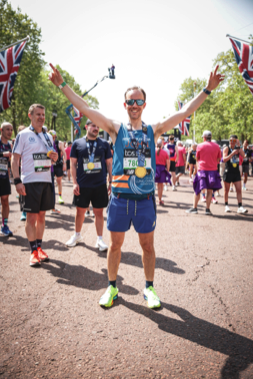
Why the Marathon?
John’s choice to run for the Roy Castle Lung Cancer Foundation was personal. Their work in research and patient support struck a chord, and having done some of their events before, John knew this was a challenge worth taking on.
With a fundraising target of £2,200, John and his wife (with her famous candles and bake sales) rallied the troops, and the local community got stuck in. By race day, they’d smashed it.
The Physio Who Knows Running Inside Out
John’s not just “a bloke who runs”. He’s our running gait analysis specialist at the clinic. That means he spends his days helping runners of all levels — from 'Couch to 5K' newbies to seasoned marathoners — run more efficiently and avoid injuries.
“Every niggle, every ache in training… I’ve been there. That’s why I’m so passionate about helping runners understand how their bodies move. A small tweak in your gait can save you a lot of grief down the line.”
The Training Struggle is Real
John’s marathon training hit 60 miles a week at its peak. That’s a lot of podcasts. He mixed in local races like the Rugeley 10 Mile and Stafford Half Marathon as practice runs.
But as any runner knows, training doesn’t always go to plan. A poorly timed cold threw a spanner in the works just weeks before London, forcing a tactical retreat and extra rest.
“Training plans are guides, not gospel. Your body needs time to adapt, and setbacks are part of the journey. It’s all about managing the load — same as I tell my clients.”
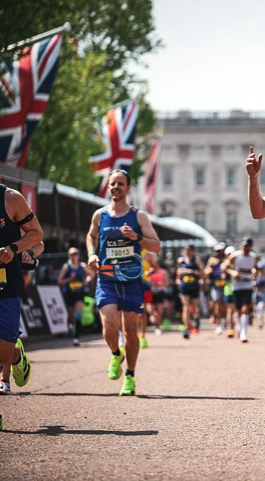
Marathon Day: Blood, Sweat & Cheers
Race day brought sunshine, sweat, and the electric buzz of 60,000 runners flooding London’s streets. Crowd support was unreal, especially at landmarks like Cutty Sark and Tower Bridge. A surreal highlight? Seeing Eliud Kipchoge fly past on the opposite side of the course.
But despite smart pacing and hydration, cramp hit hard in the final miles. Yet, John powered through, fuelled by the support of family, friends, and the thought of the charity he was running for.
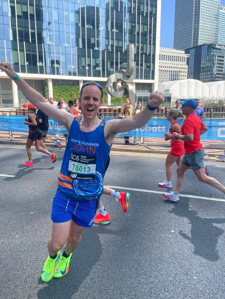
John Spots His Family at Mile 21
Crossing the Finish Line (and What Comes Next)
Turning past Buckingham Palace towards the finish was emotional. Months of training, sacrifice, and community support all leading to this moment. Relief, pride, exhaustion — all rolled into one.
But is John resting on his laurels now? Not likely.
“Chester Half Marathon’s up next, and then I’m chasing a new 5K PB. Running’s addictive like that.”
Could John Help Your Running?
If you’re a runner — whether you’re plodding your first 5K or chasing marathon glory — John’s your man. His gait analysis sessions can help you:
- Run more efficiently
- Reduce injury risk
- Recover better
- Enjoy running more
Because it’s not just about going faster. It’s about running smarter, staying pain-free, and making sure your body can cope with the miles.
Fancy a Chat About Your Running?
If John’s marathon story has got you thinking about your own running journey, why not book in for a gait analysis session? Whether you’re struggling with a niggle, want to improve your form, or simply want to avoid the common pitfalls, John’s been there, done that, and got the sweaty T-shirt.
And if you’d like to support his marathon fundraising (it’s still open), you can donate here:
Call us on 01889 881488 or click here to book your running gait analysis with John.
Nicky Snazell Clinic leads where others follow
Nicky Snazell Clinic has been at the leading edge of introducing new technology since it opened in 2007. We are delighted to announce that this time we have done it again, not just once but twice. Yes, we have added two new technologies that are rarely available in the UK.
And these technologies can help treat conditions that previously we were unable to treat.
Many years ago, we added radial shockwave to our arsenal of technology, one of the first clinics in the UK to do so. It was relatively so new in the UK that we had to go to France and Luxembourg to get quality training. As a result, we have had considerable success in helping to treat the causes of pain which were shallow in the body, up to 3cm deep. Since then, and rightly so, many other clinics have seen the benefits of radial shockwave and added it to their capability.

A significant limitation of radial shockwave, however, is that its effective depth is too shallow to treat many conditions. It is also too painful to treat many superficial problems like tennis or golfers’ elbow and would be out of the question for bone fractures.
Focussed shockwave is able to deliver far more energy than radial shockwave, and with far greater precision.
Focussed shockwave is very different to radial shockwave. Whereas radial shockwaves are greatest at the skin surface and then become weaker as they diverge, focussed shockwaves converge as they penetrate the body, reaching their maximum energy at the focus point, around 12.5cm deep. The actual treatment depth is adjustable by spacers, thus allowing treatment at any depth up to 12.5 cm.
Focussed shockwave is able to deliver far more energy than radial shockwave, and with far greater precision. As a result, focussed shockwave can treat many conditions that are not possible with radial shockwave. Focused shockwaves are high energy sound waves that are delivered deep into damaged tissue with high precision. These high energy waves increase blood flow, improve overall cell structure, stimulate stem cells, release growth factors and have an analgesic effect whilst stimulating the body’s natural repair and regeneration processes.
What can we treat with focussed shockwave?
- Osteoarthritis
- Tendinopathies
- Insertional tendinopathies
- Carpal tunnel
- Deep seated tendons
- Medial tibial stress syndrome
- Bone fractures
- Stress injuries
- Stress fractures – non unions
- Degenerative Pathologies
- Osteitis Pubis
- Spinal facet joint pain
- Coccydynia
- Acute pain and flare ups
- Wound healing
- Chronic pelvic pain syndrome
Want to get better faster? Focused shockwave can provide fast pain relief and increased mobility.
EMTT
The second technology we have added is even more rare than focussed shockwave. There are very few in the UK. It’s called Extracorporeal Magneto Transduction Therapy (EMTT) and it’s a new state of the art therapy available at Nicky Snazell Clinic.
EMTT is highly tolerated, even with the most painful conditions.

EMTT uses high energy magnetic fields for regeneration and rehabilitation at a cellular level. It can penetrate the body up to 18cm deep stimulating biological processes and speeds up tissue repair. The treatment initiates an anti-inflammatory response, reducing pain and inflammation in affected areas of the body, making it perfect for clients with:
- Acute pain presentation
- Irritable flare ups
- Neuropathic pain
- Diffused pain
- Degenerative pain such as osteoarthritis
- Rheumatic conditions
EMTT is highly tolerated, even with the most painful conditions. It speeds up the healing of tendons, bones and nerves.
During treatment, painful areas of the body are treated with high-energy magnetic pulses of such intensity that it is possible to achieve a therapeutic effect in the cells. The individual pulses penetrate the tissue so that even deeper tissue layers can be reached.

What can we treat with EMTT?
- Osteoarthritis
- Non-specific lower back pain
- Nerve entrapments (carpal tunnel, sciatica)
- Bursitis
- Rheumatologic pain
- Diabetic neuropathy
- Non-union fractures
- Stress fractures
- Osseocronosis
- Implant osseointegration
- Tendinopathies
- Plantar fasciitis
- Accelerated sports recovery
Combined Treatment
Not surprisingly, focussed shockwave and EMTT complement each other. Better and faster results have been obtained by combining these two technologies.
Ask your therapist for more information.
